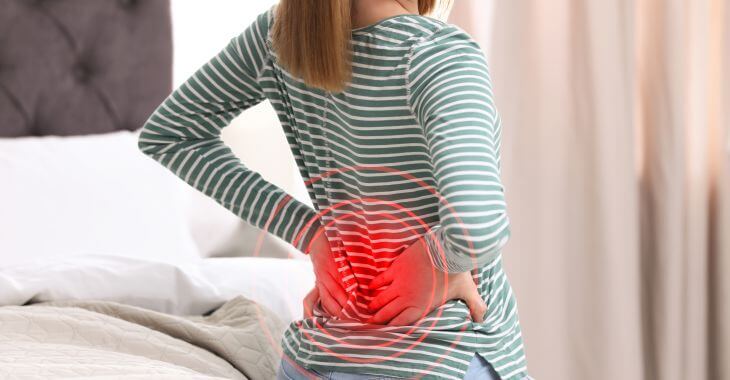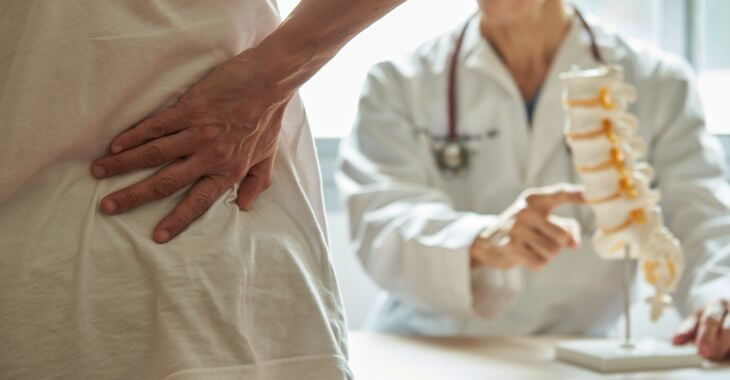How to Sleep with Lower Back Pain

Lower back pain can impact your comfort 24/7, including interrupting your sleep. There are multiple spine and musculoskeletal issues that can cause lower back pain as well as sciatica, including herniated discs, osteoarthritis and muscle spasms. If your lower back pain is keeping you awake, or you wake up with severe sciatica symptoms, changing your sleep habits may give you relief. Here are some tips on how to sleep with lower back pain and sciatica to get the rest and relief you need.
A good night’s sleep can be difficult enough to achieve without back pain. When you have chronic back pain or sciatica from a herniated disc or other back condition, getting enough deep sleep can be hard. Getting and staying comfortable for several hours is not easy with a bad back; and even if you do sleep, you could be causing more stress on your spine. Knowing the right positions and sleeping devices to use can make a big difference for managing your lower back pain.
Best Sleep Positions for Lower Back Pain
The position of your spine is important when considering how to sleep with lower back pain and sciatica. The ideal position puts minimal stress on your spine, allowing it to rest in a natural alignment. While everyone may have a favorite sleep position, some should be avoided to reduce pressure on your spine. For example, sleeping on your stomach, or face down, can put the most stress on your spine, resulting in more pain in the lower back and aggravating sciatica conditions. Here are some of the best sleep positions for lower back pain:
- Sleep on your back. If you can sleep on your back, you can relieve the pressure on your spine. This position distributes your body weight evenly to avoid putting too much stress on the lumbar spine. Using a flatter pillow under your head and a small pillow under your knees can improve your alignment for even better sleep.
- Sleep on your side. Sleeping on your side is another option to reduce spine stress. To align and support your spine, use a pillow between your legs to lift the top leg and support the hip. You may need a thicker pillow for your head to support the neck when sleeping on your side.
- Sleeping on your stomach. If you must sleep on your stomach, it is best to sleep without a pillow or use a very flat pillow. However, this position should be avoided, if possible, to relieve lower back pain and sciatica.
Your sleep position can make a significant difference in how well you sleep and reducing stress on your spine. Not only will you feel more rested, but it can reduce your lower back pain and sciatica symptoms while you are awake.
How Your Bed Impacts Your Lower Back Pain
Your sleep position is important, but so is the support from your mattress. If you want to know how to sleep with herniated disc or lower back pain, you should consider where you sleep. To relieve lower back pain or sciatica caused by a herniated disc or other spine problems, you need a good sleep support system.
There are thousands of different types of beds and many different opinions on which beds offer the best support. For lower back pain, herniated discs and sciatica, firmer or harder mattresses tend to provide more support. Soft mattresses are considered the worst support, allowing pressure points where the spine curves, even when you sleep in the correct position. If you prefer a softer mattress, you still want to ensure it is firm enough to give your spine support.
Mattresses can be expensive, but if you have chronic lower back pain or sciatica, it is worth the investment to find a good mattress. If your mattress is several years old or on the softer side, it may not be providing the support you need to get quality sleep.
Sleep Preparation
If you have trouble sleeping due to lower back pain, you may want to prepare your back before you go to bed. Your doctor can give you recommendations for nighttime lower back pain relief options. Some possible solutions include:
- Stretching exercises for your lower back muscles
- Applying heat to the back before bedtime – a hot shower, bath or heating pad may offer lower back pain relief
- Using anti-inflammatory medications
- Topical medications for pain relief

Knowing how to sleep with lower back pain and sciatica can ensure you get the rest you need while reducing stress on your spine. If you have chronic lower back pain, sciatica or a herniated disc, talk to your doctor about the best solutions for quality sleep. With the right preparation, bed and sleep positions for lumbar back problems, you can enjoy a full night of sleep and wake up refreshed.
The information provided on this website, including text, graphics, images, and other materials, is intended solely for informational purposes and should not be used as a substitute for professional medical advice, diagnosis, or treatment.

)